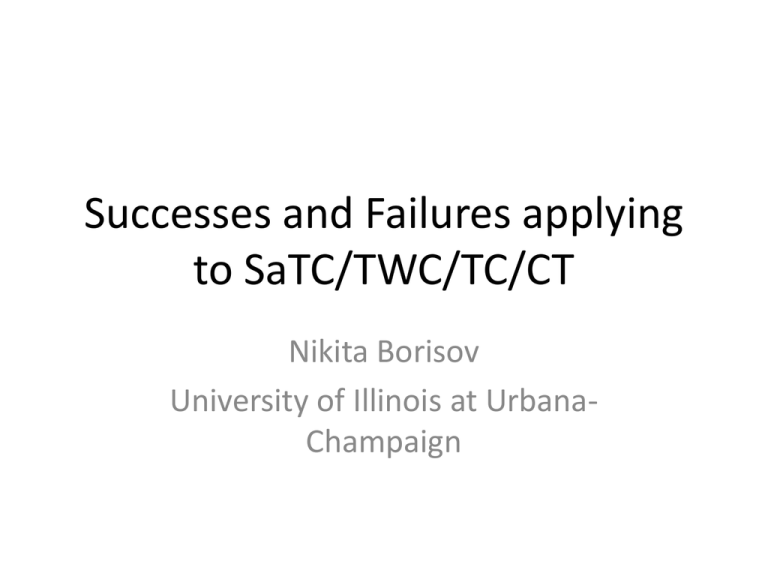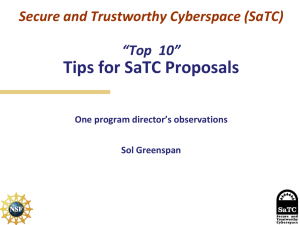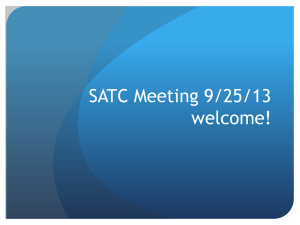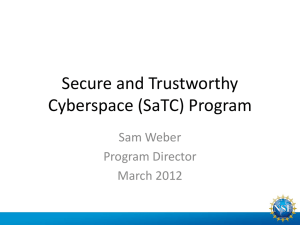Successes and Failures applying to SaTC/TWC/TC/CT Nikita Borisov University of Illinois at Urbana-
advertisement

Successes and Failures applying to SaTC/TWC/TC/CT Nikita Borisov University of Illinois at UrbanaChampaign My SaTC Experience • First PI experience in 2006 • Four funded projects through some version of SaTC – Vulnerability signatures in intrusion detection – Security and privacy in building automation – Network traffic analysis – Anonymous communications (CAREER) • About as many rejections • Half dozen panels Vulnerability Signatures • Traditional signatures in intrusion detection: recognize attack – E.g., “AAAA….AAAA?idapi.ida” for CodeRed • Too specific: – CodeRed II used “NNNN….NNNN?idapi.ida” • Vulnerability signatures: recognize attack vector • Challenge: faithfully reconstruct application parsing state with high performance Behind the Proposal • Genesis: internship at Microsoft Research as graduate student • Development: – Identify basic research challenges – Create evaluation strategy • Collaboration: – Two senior co-PIs / mentors Building Automation • Newer buildings use networked sensors and controls for lights, doors, HVAC, etc. • Opportunity for applications that enrich inhabitants’ lives • Woefully insecure • Challenge: design interface that enables applications while preserving important privacy and security constraints Behind the Proposal • Genesis: Class project on applications for building automation • Development: – Identify general principles that can be applied in this setting • Collaboration: – My co-instructor in the course Traffic Analysis • Encrypted network traffic contains patterns: packet sizes, timings, counts, … • Side channel that reveals information – User identity – Password characters – Web page content – VoIP phrases • Challenge: Rigorous, systematic understanding of attacks and defenses Behind the Proposal • Genesis: Attack paper on network watermarking schemes • Development: – Identify several important problems – Formulate fundamental theoretic questions – Connect them to experimental validation plan • Collaboration: – Co-author from attack paper – Another communications expert – Senior mentor Anonymous Communications • Internet communication leaks metadata about interests, relationships, behavior, etc. • This information is (ab)used by ISPs, employers, advertisers, intelligence agencies, repressive regimes, … • Anonymity networks, such as Tor help protect metadata, but at a large performance cost • Challenge: creating scalable, high-performance overlay networks while minimizing leaked information Behind the Proposal • Genesis: PhD work, followed by several years of research • Development: – Detailed description of next few research papers • Collaboration: – Support letters from foreign collaborator Lessons from Rejections • SaTC panelists are notorious skeptics! – Your job to convince them your approach will work and be secure • Missing related work can be a killer – Spend twice as much time as you think you need • Avoid being too broad Closing Thoughts • Get thee on a panel! – Can’t beat first-hand experience – PMs often struggle to fill slots • Get co-PIs with prior SaTC successes – Can be helpful even at a low commitment level • Enjoy the experience! – Even unfunded proposals have payoffs



